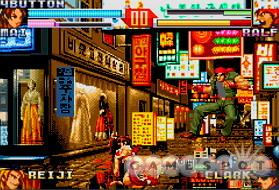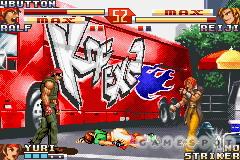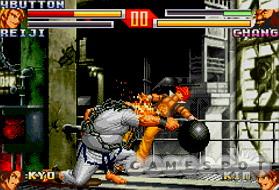Regardless of your past experience with one-on-one fighting games--whether you've been performing quarter-circle motions since the days of Street Fighter II or whether you're just now looking for a brawler to take with you on the go--King of Fighters EX2: Howling Blood is the kind of arcade-style beat-'em-up that belongs in your collection.

In many ways, EX2 is like Street Fighter Alpha 3, Guilty Gear X, and the majority of other fighting games that are already available for the GBA. Basically, two fighters square off in an urban setting--one on the left-hand side of the screen and one on the right. Somewhere in the middle, punches are thrown, attacks are blocked, and all manner of fanciful flames and fireballs are tossed around, thanks to those aforementioned quarter-circle motions. As the match proceeds, a power gauge at the top of the screen fills up a little bit every time you successfully land an attack. When you fill up a bar on the power gauge, you can perform a character's desperation move, which is a flashy attack that typically unleashes multiple hits on your opponent, thus inflicting a massive amount of damage. The power gauge can store three of these desperation attacks. Ultimately, a poorly timed jump usually results in someone taking the brunt of one of these desperation moves, like Terry's Power Geyser. The winner is the player with the most stamina left at the end of the round.
These kinds of games are fun because they let players act out a supernatural kung fu cartoon right in the palms of their hands. EX2 stands out from the crowd because it has what fans of the genre refer to as the "SNK style." This means that the characters look glossier and grittier than those you'll see in other fighting games. Furthermore, this means that moves called taunts, guard-cancels, hop-backs, and desperation specials are all as equally important to winning the match as the basic punches and quarter-circle-forward special moves that you'll find in any fighting game. This sort of variety does add a layer of complexity that you won't typically find in your average 2D beat-'em-up, but the additional learning curve pays off in livelier matchups. It's also worth mentioning that every game in the King of Fighters series was designed with a four-button control layout in mind. The series had its start in the arcades on the Neo Geo MVS hardware, which only has four buttons, as opposed to the six used by Capcom's Street Fighter II games. Because of this, KOF EX2 is perfectly suited to the GBA's button layout and doesn't cut corners with respect to the execution of attacks or special moves. Capcom's Street Fighter Alpha 3--originally a six-button game--suffered in its transition to the GBA because medium attacks had to be performed by pressing two buttons together.
SNK style also refers to the game's teamplay setup. In most fighting games, you pick a single fighter and compete against one opponent after another in matches that consist of a best-of-two-rounds series. In EX2, you choose a team of three characters and go up against other teams. The first character you select takes the leadoff spot and will continue to fight until he or she is knocked out. When one of your fighters is KO'd, the next one in line takes his or her place. The other component of the teamplay setup is called the striker system, which is a set of attacks that allow you to call for backup when you press the B and L buttons simultaneously. You can use these striker attacks to distract the opponent when you're in trouble, or you can chain them together--along with regular moves--to create custom combinations. The previous King of Fighters game for the GBA, KOF EX: Neo Blood, reserved six of the 24 characters on its roster strictly for use as strikers. Not only did this reduce the actual cast to 18 playable characters, but it also meant that you couldn't do anything with popular characters, like Joe Higashi or Yuri Sakazaki, except use them to break into matches with cheap shots. In EX2, the striker system has been fixed so that it doesn't subtract from the list of playable characters. The next teammate in line to fight acts as the striker for the character who's currently fighting. For instance, if you pick Terry, Andy, and Mai to be on a team together, then Andy will back up Terry and Mai will back up Andy. Unfortunately, the last character in the lineup doesn't have a striker to back them up, but that's part of the strategy you'll need to consider when forming a team.

Besides the revamped striker system, King of Fighters EX2 improves upon its predecessor in a number of other ways. The most visible of these fixes includes the fact that fallen characters now appear hunched over or collapsed in the background once the next fighter takes over. This may sound like a frivolous feature, but it has been a part of every KOF game--with the exception of EX: Neo Blood. Attacks also don't glitch out and pass through characters like they used to, and the controls have been made more responsive, which, along with a greatly expanded selection of moves, makes this KOF game feel more like one of its arcade counterparts and less like a ramshackle port. The roster includes 22 different characters who are mainly holdovers from the KOF arcade games, like Terry, Mai, Iori, K', and Kyo, among others. Three new characters, named Jun, Miu, and Reiji, are exclusive to this latest game. Jun and Miu aren't particularly interesting, but Reiji fits right in with the usual cast, thanks to his pretty-boy good looks and the mysterious cameos that his young female companion makes during his prematch warm-ups. Play options include the usual assortment of modes you'd expect to find in a one-on-one fighting game, like story, two-player team, two-player single, and practice.

If you've played any of the previous KOF games in the arcade or at home on the Neo Geo AES console, you'll be happy to know that EX2: Howling Blood on the GBA looks, sounds, and feels like a King of Fighters game ought to. The characters are large, the variety of sound effects is superb--and includes speech clips for special moves and round call-outs--and the backgrounds make use of the kinds of daylight and weather-related special effects that you don't often see in a GBA game. As far as the overall presentation is concerned, EX2 is a class act all the way--from the fiery menus and Japanese animation-style character portraits to the conversations that take place between matches and at the end of the game. The only place where the game noticeably comes up short is in its music, which, while upbeat and reminiscent of classic KOF tunes, doesn't quite live up to the standards set by some of the system's more recent games.
King of Fighters EX2: Howling Blood has positioned itself as the standard that subsequent fighting games published for the Game Boy Advance must meet or beat. It compromises nothing in delivering the arcade KOF experience to the palm of your hand.